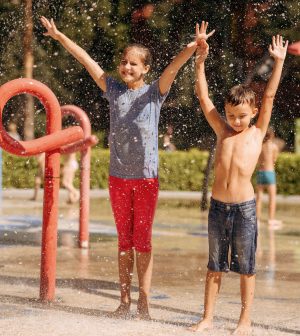- See What Saffron Can Do for Sleep and Heart Health
- 6 Common Mistakes to Avoid Before Your Physical
- Can Sweating Really Help You Beat a Cold?
- Strengthening Your Relationship: Practical Strategies
- Skip Storing This Everyday Product in the Fridge Door
- Green Tea + B3 Pairing May Boost Brain Health
- Navigating Your Midlife Crisis: Embracing New Possibilities
- City Raccoons Showing Signs of Domestication
- Mapping the Exposome: Science Broadens Focus to Environmental Disease Triggers
- One Week Less on Social Media Linked to Better Mental Health
Nowhere Safe to Play: ‘Play Deserts’ Keep Kids from Fun Physical Activity

The problem of “food deserts” in many parts of the United States has gained attention in recent years. Now, researchers are highlighting a similar issue: play deserts.
In a recent study, investigators at the University of Georgia found that in many areas of the country — particularly the South — families have few safe, free parks and playgrounds for their kids to enjoy.
That’s a problem, experts said, because when kids lack those opportunities, they’re more likely to stay inside and stare at screens.
It’s well known that there are communities nationwide where people have a hard time getting to a grocery store or any other source of fresh, nutritious food. Those places have been dubbed food deserts, and an estimated 10% of the United States falls into that dubious category.
The new findings show that a similar percentage can be considered play deserts, according to researcher Lan Mu, a professor of geography at the University of Georgia, Athens (UGA).
Many play-deficient counties are clustered in the Southeast, where a lack of options and the quality of existing play areas are often problems, the study found. The Southwest was another hotspot for play deserts, and a common issue was affordability: Some places require a membership or fee to enter.
It’s not enough that parks or playgrounds merely exist in a community, said lead researcher Jue Yang, a doctoral student at UGA.
Those places also need to attract families, she said. Parents care about safety and whether playground equipment is well-maintained — as well as practical things like parking, walkability, bathrooms and having shady areas to get out of the blazing sun.
The findings, published recently in the International Journal of Geo-Information, add to growing concerns about U.S. kids’ lack of outdoor time — especially in low-income communities.
“National data show that the proportion of children spending time outdoors has decreased,” said Amanda Staiano, an associate professor of pediatric obesity and health behavior at Pennington Biomedical Research Center in Baton Rouge, La.
Staiano, who was not involved in the study, said that only about two-thirds of American kids live in what can be considered a safe environment. And that percentage is lower among children of color.
“Parents’ perceptions of crime and safety cause them to restrict their children from playing outdoors,” Staiano said. She and her colleagues have found that is especially true for parents living in disadvantaged neighborhoods and those of teenage girls.
This is where communities should step in, according to Staiano.
“Communities should invest in safe parks and recreational facilities with good lighting, frequent security patrols and safe equipment to enable free physical activity options,” she said.
For the latest study, the researchers used machine learning technologies to determine how U.S. counties are doing in terms of residents’ access to public play areas. They applied the “5 A’s” to rate counties: availability, accessibility, accommodation, affordability and acceptability.
Overall, the South was home to more play deserts than other areas of the country. Deserts were also more common in rural areas than in cities — though in the South, even urban areas often lacked adequate play space.
Kids in rural areas may have more opportunities to get out into nature, or at least a backyard, than city kids do.
But, Yang pointed out, parks and playgrounds also offer children places to socialize with other kids and to play organized sports and games.
In more urban areas, Staiano said, there are also ways to make streets friendlier to outdoor family time — including protected bike lanes and sidewalks that are “buffered” from vehicles.
Another option for communities, she added, is to negotiate “joint use agreements” — where schools and other venues are turned into public recreation areas during off-hours.
For their part, the UGA researchers plan to make interactive maps available online, to help county policymakers determine how to create more play areas in their communities.
More information
The American Academy of Pediatrics has advice on helping kids get moving.
SOURCES: Lan Mu, PhD, professor, geography, University of Georgia, Athens; Jue Yang, doctoral student, geography, University of Georgia; Amanda Staiano, PhD, associate professor, pediatric obesity and health behavior, Pennington Biomedical Research Center, Louisiana State University, Baton Rouge; International Journal of Geo-Information, March 21, 2023, online
Source: HealthDay
Copyright © 2025 HealthDay. All rights reserved.










